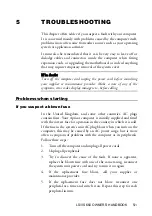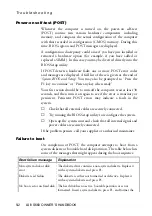
E x p a n s i o n c a r d s
LS/VS660 OWNER’S HANDBOOK 4/5
where the card’s memory begins within the address space. Typically,
an expansion card’s memory must be mapped onto the addresses
between C8000h and DFFFF in upper memory. With most
modern expansion cards this is fully automatic.
The card’s documentation should list its possible base memory
addresses. You will also need to know how much memory the card
has, so that you can leave the right gap between this card’s base
address and the next.
Cards often come with pre-configured or default settings. It is best
to rely on these settings as much as possible, and change them only
if they conflict with other devices.
Installing a card
Installing expansion cards can be one of the most difficult
operations you may ever perform within your computer. If you are
in any doubt, or come into difficulties you are unable to resolve,
contact the supplier of the expansion card or ask your Apricot dealer
for advice or assistance.
1. Turn off the computer and unplug all power cords. Take
suitable anti-static precautions and remove the system side and
top panels, detailed information is given in chapter 1.
Caution
Caution
If you are unfamiliar with the recommended anti-static precautions,
refer to the antistatic section at the rear of this handbook.
2.
At the rear of the system unit are metal blanking plates, one for
each expansion card slot. To ensure the front edge of a full
length card is securely supported you will find card guides on
the front of the machine, on the back of the fan assembly.
3. First decide in which of the available slots you wish to install
the card. Not all slots will accept the same type of card.
4. Remove the blanking plate of the chosen slot by removing its
securing screw, then sliding the blanking plate out of its slot.
Keep the screw, it will be needed later to secure the card.
















































